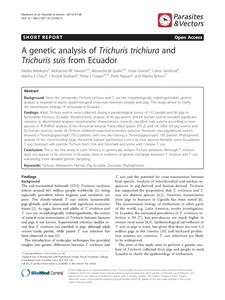Meekums, H; Hawash, MB; Sparks, AM; Oviedo, Y; Sandoval, C; Chico, ME; Stothard, JR; Cooper, PJ; Nejsum, P; Betson, M
(2015)
A genetic analysis of Trichuris trichiura and Trichuris suis from Ecuador.
Parasit Vectors, 8 (168).
ISSN 1756-3305
https://doi.org/10.1186/s13071-015-0782-9
SGUL Authors: Cooper, Philip John
![[img]](https://openaccess.sgul.ac.uk/107446/1.hassmallThumbnailVersion/A%20genetic%20analysis%20of%20Trichuris%20trichiura%20and%20Trichuris%20suis%20from%20Ecuador..pdf)  Preview |
|
["document_typename_cannot open `/data/SGUL/sgul/eprints3/archives/sgul/documents/disk0/00/10/74/46/01/A' (No such file or directory)
cannot open `genetic' (No such file or directory)
cannot open `analysis' (No such file or directory)
cannot open `of' (No such file or direct" not defined]
Published Version
Available under License Creative Commons Attribution.
Download (504kB)
| Preview
|
Abstract
BACKGROUND: Since the nematodes Trichuris trichiura and T. suis are morphologically indistinguishable, genetic analysis is required to assess epidemiological cross-over between people and pigs. This study aimed to clarify the transmission biology of trichuriasis in Ecuador. FINDINGS: Adult Trichuris worms were collected during a parasitological survey of 132 people and 46 pigs in Esmeraldas Province, Ecuador. Morphometric analysis of 49 pig worms and 64 human worms revealed significant variation. In discriminant analysis morphometric characteristics correctly classified male worms according to host species. In PCR-RFLP analysis of the ribosomal Internal Transcribed Spacer (ITS-2) and 18S DNA (59 pig worms and 82 human worms), nearly all Trichuris exhibited expected restriction patterns. However, two pig-derived worms showed a "heterozygous-type" ITS-2 pattern, with one also having a "heterozygous-type" 18S pattern. Phylogenetic analysis of the mitochondrial large ribosomal subunit partitioned worms by host species. Notably, some Ecuadorian T. suis clustered with porcine Trichuris from USA and Denmark and some with Chinese T. suis. CONCLUSION: This is the first study in Latin America to genetically analyse Trichuris parasites. Although T. trichiura does not appear to be zoonotic in Ecuador, there is evidence of genetic exchange between T. trichiura and T. suis warranting more detailed genetic sampling.
Statistics
Item downloaded times since 17 Jul 2015.
Actions (login required)
 |
Edit Item |



